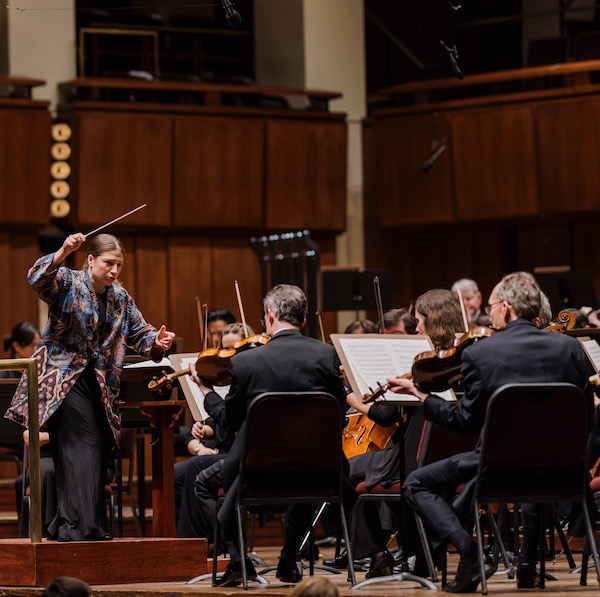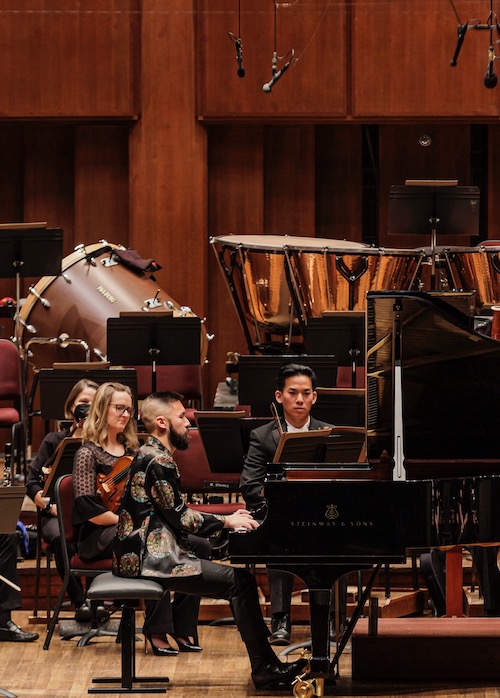Dueling debuts, boisterous energy at NSO concert

Dalia Stasevska conducted the National Symphony Orchestra Thursday night at the Kennedy Center. Photo: Yassine El Mansouri
The National Symphony Orchestra boiled over with dynamic verve Thursday night in the Kennedy Center Concert Hall. The fire came from the twin debuts of Finnish conductor Dalia Stasevska, an energetic presence at the podium, and the pianist Conrad Tao, the one-time child prodigy now enjoying a lively career as both pianist and composer.
The evening opened with an extended moment of calm, in the NSO’s first performance of Jessie Montgomery’s Hymn for Everyone. Co-commissioned by the NSO and written during the pandemic, the piece was premiered by the Chicago Symphony Orchestra last April. It is a stately reiteration of a hymn tune, dedicated to the composer’s mother, the playwright Robbie McCauley, who died in 2021.
Horns and violas began the tune in unison, with bell strokes and a swoosh of gong. Although the meter changed from time to time, the sense of deliberate, plodding rhythm pervaded the piece: something like the long crescendo of Ravel’s Bolero, just without the sizzle. A middle section provided some variety, with the clarinet and other winds taking the tune over a shimmer of rolled notes on tubular bells. Searching for an ending, Montgomery settled, somewhat unconvincingly, on a descending scale that came to rest on a long unison.
By contrast, Tao approached Shostakovich’s Piano Concerto No. 1 with tornadic fury. The NSO last played this piece, with its additional part for solo trumpet, in 2021 for its first live concert after the coronavirus closures. Tao rampaged explosively through the first movement, his impulsive blasting forward in tempo giving the piece a mercurial edge. Stasevska scrambled to keep the small string ensemble on track with him at times.
Scholar Laurel Fay has quoted one of Shostakovich’s former teachers as being “shocked by the brashness, the irreverent hodge-podge of styles” in this odd concerto. Tao was often moving too fast and forcefully for much of the allusions to everything from Beethoven to music-hall songs to register.

Conrad Tao performed Shostakovich’s Piano Concerto No. 1 with the NSO Thursday night. Photo: Yassine El Mansouri
His sharp-fingered octaves were equally uncompromising in the slow movement, but the velvet-toned strings gave ethereal lightness to the Mahlerian transition into the section for the bluesy muted trumpet, played with buzzing ease by NSO principal trumpeter William Gerlach. Stasevska brought out the gentle anguish of the violins’ clash and resolution from F-natural to E in the final bars.
Tao’s almost sentimental start to the third movement turned bitter and loud again, leading inexorably to another mad dash through the Finale. Emphasizing force and speed, Tao sacrificed much of the biting humor, while Gerlach’s silly tune over col legno strings provided a needed moment of respite. Tao pounded his way through the concluding cadenza with machine-like efficiency, rounding out the piece with a raucous galop ridden with efficiency by Gerlach’s silvery trumpet playing.
Saying he was building on the “slightly manic sensibilities” of the Shostakovich concerto, Tao gave a startling encore, his own transcription and modification of an Art Tatum solo, a 1954 version of Ray Noble’s “Cherokee.” From the slow introduction to its stride piano excesses, this rendition had the cohesion and thoughtfulness partly missing from the Shostakovich.
Stasevska’s last appearance in the area was with the Baltimore Symphony Orchestra in 2021, before the Russian invasion of her homeland. Born in Kyiv, the conductor has raised over $200,000 for the Ukrainian war effort, even reportedly driving supplies personally into the country. It is remarkable to realize that the historical backdrop of the last piece on the program, Sibelius’s Second Symphony, was the Russian Empire’s attempt to annex Finland, a dark parallel to the past year.
Stasevska’s interpretation has deepened since she conducted the piece with the BSO. The first movement still moved with urgency, perhaps too much, but the conductor allowed more room to breathe in between driven passages, especially in the surging brass chorale section. In the second movement, the sonorous brass were potent in the theme Sibelius scholar Andrew Barnett associated with Death, opposed by the plangent strings and twirling flutes the composer identified with Christ.
The third movement’s Scherzo section was so slipshod that the string parts blurred together, but the Trio purred with pastoral oboe and cello solos. In the Finale, Stasevska led such careful build-ups to the appearance of the main theme, one of the most beloved Sibelius ever wrote, that it seemed a shame not to luxuriate a bit more in that soaring melody. The final blossoming into the major key was marshaled with consummate skill, with the final statement of the theme drawn out into a triumphant conclusion.
The program will be repeated 8 p.m. Saturday. kennedy-center.org
